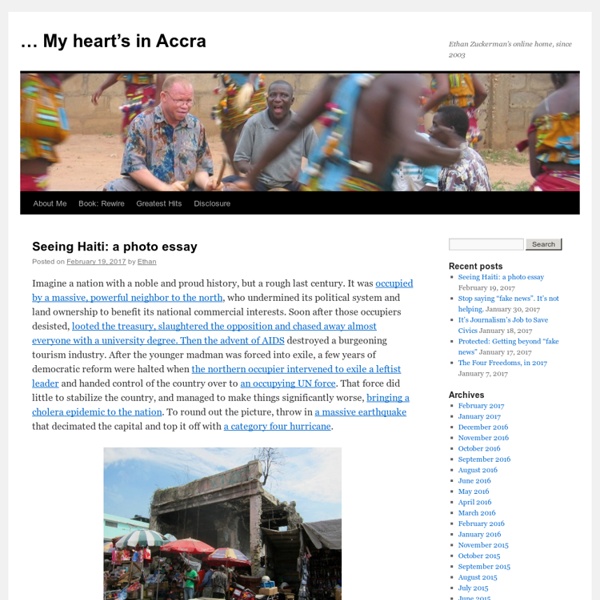An Interactive Introduction to Network Analysis and Representation
Networks and network analysis has grown more prominent in both humanities scholarship and public discourse. In this context, networks--also known as graphs or node-link diagrams--are "a set of vertices (also called points or nodes) which represent the entities of research interest, and a set of lines (or ties) between these vertices which represent their relationships." [1] This interactive application is designed to provide an overview of various network analysis principles used for analysis and representation. It also provides a few examples of untraditional networks used in digital humanities scholarship.
Govt to ensure the speedy repatriation of remaining victims: Ramaphosa:Sunday 16 November 2014
Deputy President Cyril Ramaphosa.(SABC) Deputy President Cyril Ramaphosa has stressed that the government will ensure that the remaining bodies of people from South Africa are speedily repatriated from Nigeria.
NodeXL
The simplest, easiest way to get insights into networks, try the free and open NodeXL! Network Overview Discovery and Exploration for Excel 2007/2010/2013 NodeXL provides support for social network analysis in the context of a spreadsheet.
Create a Unique Google Forms URL for Each Student
One of the presentations I did in the Google Booth at Educause this year was on using concatenate for a spreadsheet. While you do not need to know the word concatenate to do this trick, it is wickedly useful. One of the best tools in the Google Apps suite is Google Forms. It allows any user on practically any device to fill out a Form. The user does not have to be logged in, have a Google account or even know what Google is.
Studying the intersection of social networks, communication networks and computer networks
NetLab is an interdisciplinary scholarly network studying the intersection of social networks, communication networks, and computer networks. Centered at the University of Toronto, NetLab members have come from across Canada and the United States as well as from Chile, Germany, Hungary, Israel, Japan, Norway, Portugal, and the United Kingdom. NetLab has developed since 2000 from an informal network of collaborators into a far-flung virtual laboratory.
Turn a Set of Spreadsheet Cells Into Easy to Read Documents
Save As Doc is a free Google Spreadsheets Add-on that enables you to select a series of adjacent cells and turn them into an easy to read Google Document. The Save As Doc Add-on takes just a minute to install. Once installed select the Add-on from your "Add-on's" drop-down menu and click "start." After clicking "start" you can choose a set of cells or all cells to be converted into a Google Document.
4 Ways to Enhance Your Class with Google Hangouts
If you are familiar with Google Tools, then you have probably heard of Google Hangouts or even used them yourself. Hangouts is Google’s video conferencing tool, and it’s an incredibly powerful way to engage with others. In addition to standard conference calls, Google Hangouts provide a broadcasting option called Hangouts on Air.
New Google Drive | Search Results
New Google Drive: Adding Files to My Drive Tweet When performing a search in Google Drive the results will show documents you have created, documents that have been shared with you, and documents that you have opened but are not shared with you. Select File From the … Continue reading
DRAWING GRASS (Negative Drawing techniques)at MIKE SIBLEY FINE ART
What do you see when you look at this picture on the right? Do you see an ancient black drinking cup? Maybe an ebony candlestick holder? These are the positive images. Or do you see two white faces both looking at each other? Think of these faces as the areas or what I call "White Space".
Drawing Nature and Landscapes : How to Draw Nature Outdoors with Drawing Lessons Step by Step Techniques for Cartoons
How to Begin Your Sketch In doing this sketch, doubtless great difficulty will be experienced in getting the drawing at all correct. Much assistance to this end can be obtained from a slight knowledge of Perspective This will form the subject of the next chapter. How to Draw From Nature with Easy to Remember Techniques Drawing from nature and landscapes with the following easy tips to follow with helpful tutorials to create beautiful illustrations and drawings with these free drawing lessons.
Good Reference Gallery | Freshdesigner.com
Figure Drawing Reference (Scroll down for Head Drawing Reference Gallery) Photography credits below Do you want more images? Subscribers get exclusive access to my personal library of reference images, including scans of Pose File 7 and premium images from Posespace.com. Enter your email below and click the blue button to join.



